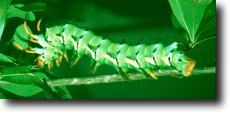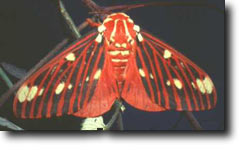The butterflies and moths are probably the most attractive and best known group of insects. Many of us are familiar with some of the large and showy moths and butterflies that grace the forests of East Texas. However, the caterpillars that eventually develop into these beautiful adult insects are not nearly as well known. Here we will consider the caterpillar (larva) called the hickory horned devil and the adult stage of this insect called a regal moth or royal walnut moth (Citheronia regalis). The hickory horned devil is the largest caterpillar that occurs in East Texas and looks like a small dragon. For some people who come across it unexpectedly, it can be very intimidating.

The hickory horned devil is the larva of the regal moth. This ferocious-looking caterpillar, which may be five inches long, is harmless.
In spite of its scary appearance, the hickory horned devil is completely harmless. A full-grown larva may be five inches long and as big around as a person’s thumb. The caterpillar’s green body is armed with large, black spines along its back and four stout, black and yellow curved horns just behind its orange head.
The caterpillar feeds on a wide variety of hardwood trees including hickory, walnut, persimmon, sweetgum, sycamore, and ash. Because of its size, the hickory horned devil can consume a considerable amount of foliage; but because the adult moth lays her eggs singly among several trees or host plants, the caterpillar doesn’t cause any significant damage. The caterpillar matures in October and that is the time of year when people usually find the hickory horned devil. When the caterpillar is full grown, it will crawl down the tree to pupate in the soil. It does not spin a cocoon, but forms a large naked pupa that is dark brown to black, over two inches long, and almost an inch in diameter. The tail is pointed and the head is rounded. The pupa will remain in the soil through the winter and the adult moth will emerge in early summer.

The regal moth is the adult of the hickory horned devil. This beautiful moth may have a wingspan of six inches, and can be found in early summer in East Texas.
The caterpillar feeds on a wide variety of hardwood trees including hickory, walnut, persimmon, sweetgum, sycamore, and ash. Because of its size, the hickory horned devil can consume a considerable amount of foliage; but because the adult moth lays her eggs singly among several trees or host plants, the caterpillar doesn’t cause any significant damage. The caterpillar matures in October and that is the time of year when people usually find the hickory horned devil. When the caterpillar is full grown, it will crawl down the tree to pupate in the soil. It does not spin a cocoon, but forms a large naked pupa that is dark brown to black, over two inches long, and almost an inch in diameter. The tail is pointed and the head is rounded. The pupa will remain in the soil through the winter and the adult moth will emerge in early summer.
If one should happen to find a caterpillar, it is not difficult to rear it to the moth stage. If a caterpillar is found still feeding on the host plant, place the caterpillar, along with some host plant foliage, in a large container (one to two gallon size). Each day, fresh foliage should be provided for the caterpillar. It would be good to place two or three inches of loose, moist soil in the bottom of the container so the caterpillar will have a suitable place to pupate when the time comes. If the caterpillar is found on the ground, chances are it has completed feeding and is searching for a place to pupate. In this case, place the caterpillar in a container with soil (as described above) and before long it will probably change to a pupa. If kept indoors, a beautiful regal moth may emerge during the winter. Sometimes the hickory horned devil will be attacked by a parasitic wasp or fly. Since the larva of the wasp or fly feeds inside the body of the caterpillar, it is usually not obvious that the caterpillar has been parasitized. A parasitized caterpillar may pupate, but rarely survives to become an adult moth.